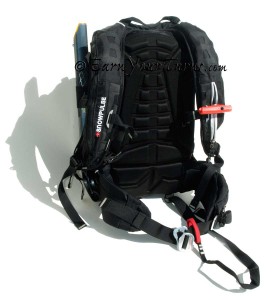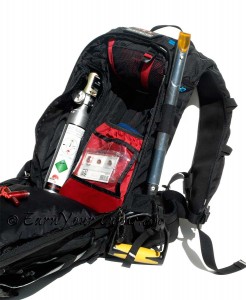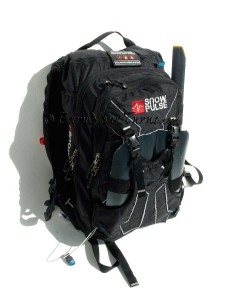Which is why the SnowPulse 24 liter HighMark pack is such delight to use. Though I’m not a climber per se, I like simple packs that aren’t cluttered. That’s part of the problem with airbag packs. Of necessity they’re more complicated than a simple rucksack, and those who try to be too simplistic end up allowing the plumbing to become a burden.
The Highmark22 from SnowPulse does a good job of balancing the need for organization with multiple compartments, without getting overly complex. The key is the strategic placement and use of zippers to create a multi-layered, compartmentalized – which sounds admittedly complex – pack that is simple and intuitive to use. They do it by never having too many options at any level, and nesting pockets and sleeves inside of each basic compartment.
Part of the reason I like it is for how closely it resembles my go to pack, BD’s Covert AvaLung. It features two main clamshell compartments accessed by large, bomb-proof zippers around the perimeter. Like the Covert, the HighMark provides an outer pocket for avy tools with a sleeve on either side that works well for stashing other essentials like skins, and is even voluminous enough for stuffing a puffy. It is not, however, quite long enough to fit a long avy probe. On first try it fits, but it takes extra care to zip past it and over time it will want to poke a hole in the fabric, or worse, the zipper.
Skis can be carried diagonally with the tails sling through a wire loop in the lower L corner paired with a removable, adjustable strap to hold ’em in the upper R corner.
The main compartment is thicker, with the same style sleeves on the inner and outer walls for organization and not much extra weight. This area will hold a jacket, a vacuum thermos, liter of water, food and other assorted stuff for a day.
The Airbag System

HighMark from the back side. The T-handle trigger folds up and stowes away inside the L shoulder strap.
Another unique feature with the SnowPulse system is the ability to test the pull trigger and feel the release tension of the puncturing pin without releasing any compressed air. With other mechanical systems a valve is used, so the only way to feel any trigger tension is with it connected to a cartridge. Ideally one should fire off the airbag at least once per season to test it, however, if you blew the budget on the pack, just testing the mechanical feel of the trigger is a less expensive way to ‘test’ the system without having to pay for a refill or spare cartridge.

The guts of the airbag system - compressed air in the aluminum cylinder, and airbag stuffed behind your neck and in the shoulder straps.
Another benefit to the SnowPulse system is that the pressure on the system is sealed with a copper (not rubber) o-ring and the metal burst disk that is punctured by pulling on the T-handle. Valve systems are more likely to lose pressure over time.
Repacking the SnowPulse takes a bit of technique, mostly because you need to hold down the release valve while trying to squeeze out the air with your other arm and hand. Next season the valve will be off to the side where it is easier to access.
The cartridge sits neatly along the L side of the main compartment, with the Venturi valve at the top, and since the airbag is shaped, a little more than half its material is behind your neck, the rest is stuffed inside the left and right shoulder straps. Besides leaving more room in the pack for your daily junk, the airbag material in the shoulder straps gives them a more padded feel that is easy on your shoulders. That stiffer shape also makes it easier to tuck your shoulders under them.
The belt buckle is the standard, unbreakable metal latch. A single leg loop insures the pack won’t ride up on you when deployed – provided you use it. Few do.
As with other airbag packs, the HighMark only feels heavy (7 lbs., 2 oz. / 3265g) when you lift it. Once it’s on your back, the extra four pounds of hardware is easy to bear.
Is there anything not to like about the High Mark? Some might say there are too many nested sleeves and pockets within each compartment, adding unnecessary weight. Perhaps, but they do add a level of organization that can offset the weight penalty.
Of course the price may make you wince, but that’s a lot easier pain to deal with than what getting buried will feel like.
SnowPulse
HighMark 22
MSRP: $924 (pack only) + $175/refillable cylinder
Volume: ~ 22 liters
Weight (pack w/cylinder): 7 lbs., 3 oz. (3265 g)
Note: If you’re buying in-store be sure to get the shop to agree to a test run and a free cartridge refill.
Useful Video Tutorials here.
Related Posts
AK Avalanche Incident – SnowPulse saves the day.
© 2012


2 comments
2 pings
Is yearly testing becoming the recommended protocol? I have an ABS that you must buy a $150 repacement cylinder & trigger for- the company had no testing protocol other than when you first get it (comes with a spare clylinder/trigger), but SME owns them (if they still do) and uses an every 3-year testing protocol which I am following, but curious if anyone has studied the deployment failure rate (not survival rate which is only partly due to this)?
Author
@smellytele,
Well ya know…..that’s just an off the cuff comment on my part. So, now that you mention it, I’ll do some homework and see what the manufacturers recommend. I said once a year because my sense is unless users like you and I take the time to (re)familiarize ourselves with the airbag hardware at least once a season I’m afraid that we will start assuming too much and the reliability of these airbag packs will suffer with it.
Just in “testing” these packs I have been guilty of “assuming” the cartridge was connected when in fact they were not and the only reason I realized that is because I striped the packs down so I knew all the details for writing up a review. I can see this sort of carelessness rippling throughout the community with inevitably tragic consequences. That is the basis of my saying annual test firings should be done although, in reality, probably once every three years for actually inflating them should be sufficient.
[…] that perspective, then how does one explain Oakley offering a BC pack designed to incorporate the SnowPulse Removable Airbag System? As the RAS name implies, the airbag system can be removed, allowing the […]
[…] Posts Review of ABS Vario 25 Review of BCA Float 36 Review of SnowPulse Highmark 22 Review of The North Face Patrol 24 ABS Pack Review of Mystery Ranch Blackjack Review of Oakley […]